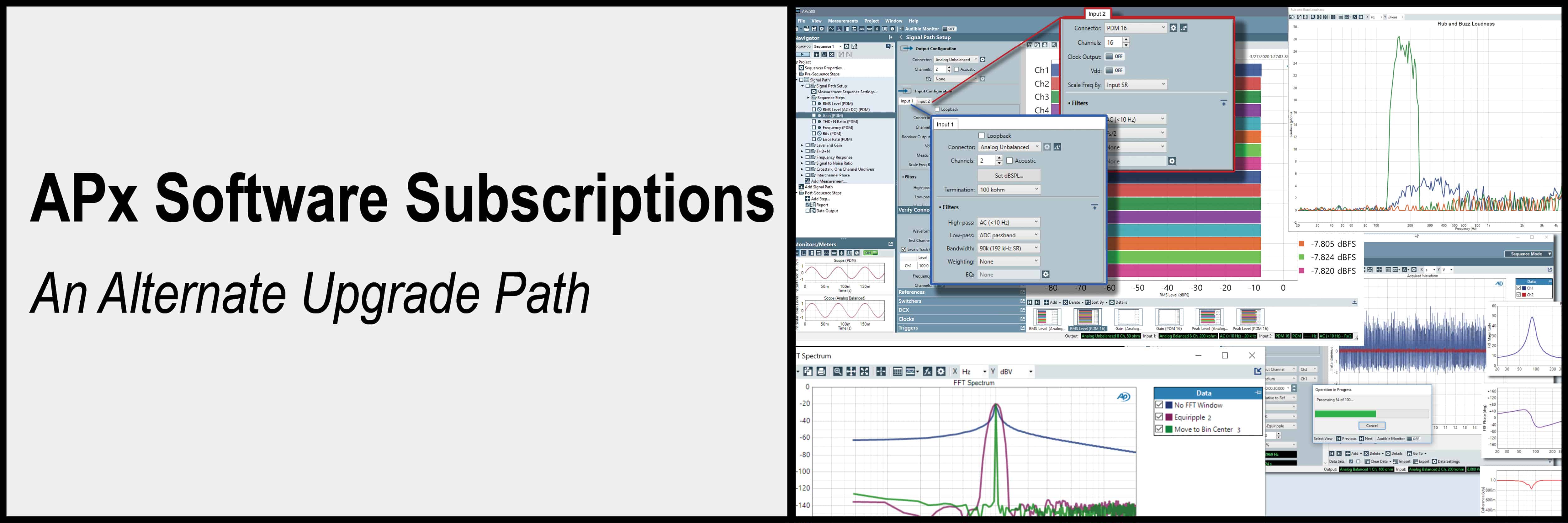The "Big Six" Audio Measurements - Part I
Benchmarks. They are vital to ensure the R&D team produce a compelling new product or service and are essential on the production line of a manufacturing facility. In audio test, there are a small number of performance benchmarks that are most important when evaluating a device-under-test (DUT). We call them “The Big Six” measurements. These are:
• Level
• Frequency Response
• Total Harmonic Distortion plus Noise (THD+N)
• Phase
• Crosstalk
• Signal‑to‑Noise Ratio (SNR)
Granted, different audio devices require different approaches for test and measurement procedures. Yet, these six measurements are critical in a variety of applications. The first three of these measurements are defined below.
Level
Level, also known as amplitude, describes how big the signal is. The greater the amplitude of the signal, the higher the level. One of the most basic audio measurements we can make, level is key in determining how much energy the device can output. Gain on the other hand, is a measurement that is commonly used for amplifiers. It’s the device’s output level divided by the device’s input level. Each DUT may have several level measurements that are of interest. Audio engineers must determine target levels. Examples include:
• An input level that produces a given output level, such as 1 volt, or 1 watt, or unity gain;
• An input level that produces a certain output distortion, such as 1% THD+N;
• An level that provides good noise performance with comfortable headroom, often called the operating level;
• An input or output level specified in a test requirements document.
Any of these levels may be used as a reference level on which we can base further measurements. Frequency response measurements, for example, are expressed relative to the level of a mid‑band frequency; THD+N measurements are made at specified levels, which should be reported in the results.
Gain Considerations for Level Measurements
The ratio of a DUT’s output voltage level to its input voltage level is the voltage gain of the DUT. For example, in a DUT with a gain of 2, an applied input of 2 volts will produce an output of 4 volts. A gain of 1, where the output voltage equals the input voltage, is called unity gain.
Some DUTs offer no gain adjustments and are said to have fixed gain. The gain may be fixed at unity, or at some other value.
Measuring Level in Variable Gain DUTs
A DUT with a volume control or other setting that affects gain is a variable gain device. When setting and measuring level, it is essential to consider whether the DUT gain is variable and, if it is, how to set the DUT controls for the desired test results.
Frequency Response
A frequency response measurement reports the output levels of a DUT when stimulated with different frequencies of known level. The simplest of all frequency response measurements consists of only two or three tones, the first near the middle of a DUT’s usable frequency range and followed by a tone near the higher extreme of the range and sometimes a tone near the lower extreme. Assuming the tones are all generated at the same level, the DUT’s output levels describe its response to these different frequencies.
Full‑range frequency response measurements can be made by several different methods, the classic being a sweep of a sine wave from the lowest frequency in the range to the highest, the results plotted on a graph. A “flat” response describes the shape of a graph where the DUT responds equally at all frequencies, producing a trace with a slope of 0 and with minimal variations. Below is an example of a typical DUT flat frequency response curve.

Figure 1: Typical DUT flat frequency response curve.
THD+N
THD+N stands for Total Harmonic Distortion plus Noise.
Harmonic distortion is the unwanted addition of new tones to the audio signal. These tones are harmonically-related tones to the original signal. When the signal is one sine wave of frequency f1, harmonic tones are f2, f3, etc., at integral multiples of the original tone. Total harmonic distortion is the sum of all the harmonics measured in the DUT’s bandwidth.
Why THD+N? Why not just measure THD (the distortion) and N (the noise) individually?
Well, at first glance it makes sense. However, in the pre-FFT days of audio measurement, it was difficult to measure the THD by itself, without the noise, but it was relatively simple to measure the THD and the N together. So, the accepted techniques handed down from years past specify THD+N, because that’s what was practical. In addition, THD+N is a convenient and telling single‑number mark of performance, widely understood and accepted.
For a more in-depth look at THD+N, read Joe Begin’s post about the measurement.
To be continued…




